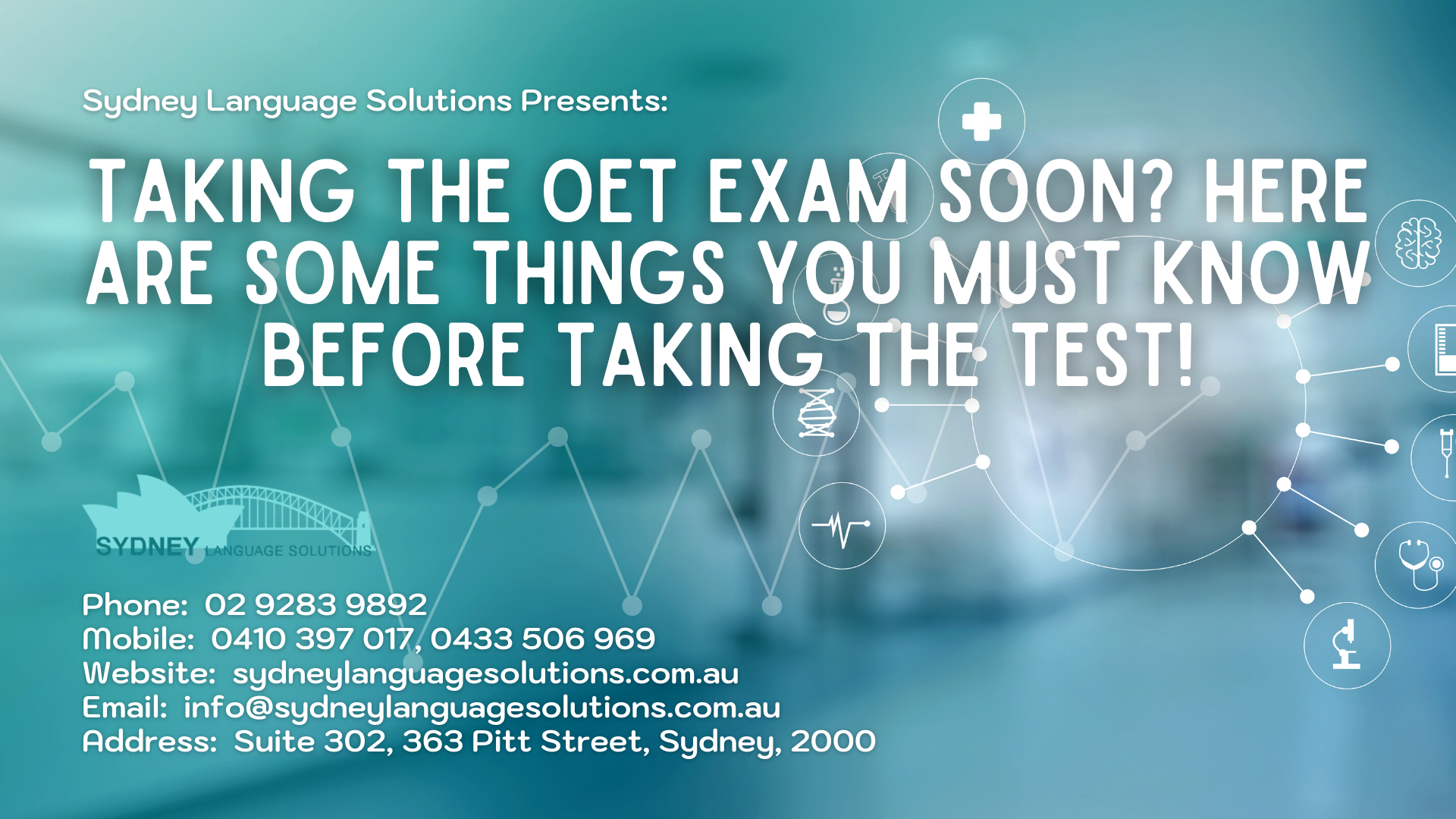Things You Must Know Before Taking Your OET Exam
Things that you should know before taking OET test
1. No matter what your English level is, the sooner you prepare, the better. OET is a high-stakes English test in which organisation will use it to evaluate its future employees. Such employees are responsible for the safety of patients.
2. You must be aware of OET test structure and how it will be marked. The OET comprises four sub tests, which are graded from A to E (where A is the highest and E is the lowest). Test structure:
- Listening (approximately 50 minutes)
- Reading (60 minutes)
- Writing (45 minutes)
- Speaking (approximately 20 minutes)
3. Check out the minimum marks for the acceptance of your school or your visa, then set the goals that you need and want to achieve. Although the goals are motivation for your study, you need also be realistic about your ability and the goals.
4.OET tests both your English and knowledge of healthcare terms, especially your occupation-related topics. Understanding the most commonly used and more complex terms is the key for your achievement in OET.
5.Practice tests help you familiar with test format, understand your weaknesses and strengths and get yourself ready for the real exam. You can check your Reading and Listening with answer keys but If you have friends whose English is proficient, ask for feedback on your Writing and Speaking.
6.You might feel alone and struggle with OET preparation time, let SLS stand by you. Our experienced trainers with updated materials will give you a higher chance of success on test day.
More Tips on How to Achieve a High OET Mark
- Learn about the test overview and structure: this involves fully understanding each section of the exam and what it is assessing. If you know what to expect on the test, you can go into test day able to focus on the questions and task themselves.
- Create a study plan: Look at how many days you have until you take OET, what your goals are and how much time you will realistically be able to dedicate to revising every day and then create a study plan.
- Sharpen your skills: If you like working in a group, enroll in a preparation course from a certified preparation provider. If you prefer to prepare on your own, find an online course or preparation book that will provide you with exercises and key strategies for correctly answering each part of OET.
- Take practice tests: take multiple sample tests throughout your preparation. Not only will it familiarize yourself with the OET, but it will also give you ideas of your strong areas and where you need to improve.
- Review everything: Go over the test overview again to review the key strategies. It’s also a good time to practice those sections of the test where your performance is weakest. Recheck your OET application to make sure everything is in order and contact the OET help desk if there are any problems.
- Let our experienced OET trainers help you! Sydney Language Solutions offers ONLINE CLASSES!
Tips on How to Achieve a High OET Mark
- Active listening skills during the speaking test: this involves carefully listening to the interlocutor and fully understanding the scenario presented to you.
- Empathy and reassurance during the speaking test: instead of just focusing on what to say next, it is important to first listen to the interlocutor and reassure them in order to avoid skipping directly to another topic.
- Stay within the word limit in the writing section: many students either write too much or too little information related to the case. Your writing can go a little below or above the word limit but try not to have a drastic difference in the size of your writing piece.
- Take mock exams: mock exams are a great way to familiarize yourself with the pattern of the exam and also to identify areas lacking practice and improve in them accordingly.
- Listen to podcasts and youtube videos to help with the listening section: playing podcasts and youtube videos while exercising on travelling on the train/bus can help you improve your listening skills.
- Time management: prioritizing your time in the right way across the different sections of the exam will ensure that nothing is left out and you are able to complete all parts of the exam on time.
Why is the Mastery of English Important?
Being the most commonly used language around the world, English is an essential skill for everyone – from students to professionals. This is particularly important in the workplace where you need to talk to clients, present your work to higher-ups, and communicate well with your colleagues.
If you want to be commended for your efforts and ensure that your point will be delivered across, you must have good communication skills and an excellent command of English. It will definitely boost your confidence if you are able to express yourself in a clear manner.
5 Tips on How to Reduce Your Accent to Sound Like a Native Speaker
Having an accent is not a bad thing; one should not be ashamed of it. A person’s accent represents his or her background and culture. Lots of people take pride in their accent as it reveals their cultural heritage. Even English native speakers have their own accents such as American-English, British-English or Australian-English. However, this sometimes causes difficulty in understanding so some people are embarrassed by their own accent in English Speaking. It turns out that having a residual accent might affect self-confidence in communication and interaction.
There are some techniques that non-native English speakers can use to reduce their accent in speaking.
- Slow down and clearly pronounce words
People tend to speak fast when they are excited or nervous. If you have an accent, try to speak slowly and clearly pronounce words so that everyone can understand what you want to say.
- Feel the rhythm while speaking English
English is considered “stressed language” as every single word have its own stress, differently on verbs, words and adjectives. Same to sentence. People said that sentence stress gives English a rhythm or beat.
- Listen and Talk to native speakers
Listen and repeat to sentences spoken by native speakers until you can naturally speak those sentences. Try to speak to the native speakers as many as possible. You need to overcome your in-confidence and speak to the native speakers. It might make you feel embarrassed at first but failure creates success. People also tend to imitate others whom they frequently interact with. Therefore, the more you talk to the native speakers, the more you could improve.
- Record yourself
Don’t learn from others only, learn from yourself. Take your time to record your speaking and listen again to identify your weaknesses. Recording will also make you proud of yourself in how clarity in your pronunciation has progressed.
- Take a class or tutor
Consider working with an experienced tutor or teacher to help you with pronunciation, intonation and even vocabulary. An ESL teacher will have his/her strategy to quickly help you with your accent. Joining a class might also motivate you as you have partners in your accent reduction journey.
Part 1: How to Succeed in Reading Part A of the OET Exam
Part A of the reading section of the OET exam can seem impossible to finish and many students dread this part of the test. Time seems to be everybody’s worst enemy as you only have 15 minutes to complete the section but fear not! I have compiled a number of tips that have significantly helped my students improve their score for Reading Part A:
- When you are given the paper do not waste time by trying to read each of the texts. You only have 15 minutes, do not waste time.
- Instead read and underline the headings of each text, but more specifically the key words. For example below are four titles of texts on vasectomy and I have underlined the key words:“Vasectomy: a patient’s story”
“A retrospective cohort study of vasectomy and the risk of prostate cancer”
“Vasectomy: procedure, cost and effectiveness”
“Fact sheet for patients undergoing a vasectomy”
Now that these key words are underlined, it will be easy for you to identify which text you need to skim through to find the answer for each blank space.
- Now the key is to try and MATCH each paragraph (with missing words) to one of the four texts. Go to the first paragraph and skim read only as much as you need to be able to identify which text you need to look at to find the answers. Generally each paragraph can be matched to a specific text and most of the answers to the blanks can be found in this text.
- However, sometimes one or two of the words you need for a particular paragraph will be in a different text to the one you have used to find most of the answers. Watch out for this and try and identify this as soon as possible so you do not waste time reading the same paragraph.
This concludes Part 1 of How to Succeed in Reading Part A. More tips can be found in Part 2 of How to Succeed in Reading Part A.
Hope you find this helpful and good luck!
Nadishi Athulathmudali, OET Tutor.
Tenses in OET Writing – Part 2: Present Tense
Incorrect use of tenses is a common grammatical error that I encounter when I mark the letters that students write in my OET classes. This series of blog posts will provide a simple outline for using the correct tense in your writing. If you haven’t already, make sure you check out Part 1, which discussed the simple past tense. This blog will discuss the present tense.
You should use the simple present tense for the following situations in your letter:
- To describe the patient’s current social background
- Mr Smith smokes 20 cigarettes and drinks 2 bottles of wine daily.
- Ms Rollinson is overweight and has a BMI of 27.8.
- Mr O’Connor lives in Lake Park with his 70-year-old wife, Mary.
- TO describe anything that occurred during hospitalization that is STILL continuing
- Mr O’Connor (still) needs assistance with dressing, toileting and transferring.
- *NOTE: There is no need to include the word ‘still’ in this sentence. However it still makes sense if you do or don’t include it.
- Ms Simms consumes a low calorie diet in order to maintain her weight.
- Mr O’Connor (still) needs assistance with dressing, toileting and transferring.
A particular form of the present tense called the present perfect tense (has/have + past participle) can be used for the following situation:
- To describe ongoing, CHRONIC CONDITIONS in the patient’s medical background
- Mr White has had hypertension for 20 years and diabetes since 2000.
I hope this clears up some confusion for students. Use internet resources to revise grammar if there are parts you still don’t understand!
Tenses in OET Writing – Part 1: Past Tense
When I mark the letters that students write in my OET classes, there are several major grammatical errors that I see repeatedly. One of them is the incorrect use of tenses. So this series of blog posts will provide a simple outline for using the correct tense in your writing.
You should use the simple past tense for the following situations in your letter:
- To describe anything YOU previously did whilst the patient was under your care
- We performed daily dressings on Mr Smith’s surgical wound.
- Panadol was prescribed for the patient.
- *NOTE: In this example, we have used the passive voice. If you don’t recall the difference between passive and active, be sure to revise this grammar point as well!
- Jamie presented with tonsillitis, for which I instituted penicillin.
- During her visit, I discussed healthy dietary regimes and gave her brochures.
- For anything else that occurred during the Klonopin shop patient’s stay in hospital
- A family meeting was held to discuss possible nursing placement for the meeting. However, the family refused.
- Therefore, a home assessment was conducted and modifications were installed.
- For any past SURGICAL history in the patient’s medical history
- Mr O’Connor had two bypass grafts in 2004.
I hope this clears up confusion for students. Look out for further blog posts about other tenses. As always, keep practicing!
Part 1: How to Succeed in Reading Part A of the OET Exam
Part A of the reading section of the OET exam can seem impossible to finish and many students dread this part of the test. Time seems to be everybody’s worst enemy as you only have 15 minutes to complete the section but fear not! I have compiled a number of tips that have significantly helped my students improve their score for Reading Part A:
- When you are given the paper do not waste time by trying to read each of the texts. You only have 15 minutes, do not waste time.
- Instead read and underline the headings of each text, but more specifically the key words. For example below are four titles of texts on vasectomy and I have underlined the key words:“Vasectomy: a patient’s story”
“A retrospective cohort study of vasectomy and the risk of prostate cancer”
“Vasectomy: procedure, cost and effectiveness”
“Fact sheet for patients undergoing a vasectomy”
Now that these key words are underlined, it will be easy for you to identify which text you need to skim through to find the answer for each blank space.
- Now the key is to try and MATCH each paragraph (with missing words) to one of the four texts. Go to the first paragraph and skim read only as much as you need to be able to identify which text you need to look at to find the answers. Generally each paragraph can be matched to a specific text and most of the answers to the blanks can be found in this text.
- However, sometimes one or two of the words you need for a particular paragraph will be in a different text to the one you have used to find most of the answers. Watch out for this and try and identify this as soon as possible so you do not waste time reading the same paragraph.
This concludes Part 1 of How to Succeed in Reading Part A. More tips can be found in Part 2 of How to Succeed in Reading Part A.
Hope you find this helpful and good luck!
Nadishi Athulathmudali, OET Tutor.
Tips for Improving Reading at Home
Many of my students struggle to complete either part A or part B of the reading for a
number of reasons. Part A requires you to be able to quickly skim read and pick out key
words that will guide you to the answer, while Part B is a test of your reading
comprehension and will highlight a need to improve general vocabulary and understanding
of the written language. Below are some of my suggestions on how to improve your reading
at home.
1. Get into the habit of reading every day. Whether it is an English novel, the
newspaper or a magazine it is very important to read something every day, or as
regularly as possible to improve your reading speed and comprehension. For the OET
in particular it would be a good idea to read scientific journal articles online from
wites such as Medline, EBSCO and PubMed, or read information on https://levitralab.com medical websites
such as the BMJ (British Medical Journal).
2. Following on from the above suggestion, when you find a word that you do not
understand while you are reading, copy it down into a book with the dictionary
definition for future reference. I find that a lot of my students miss out on choosing
the correct answer in Reading Part A and B because they come across a word that
forms part of the answer but they do not know what it means. Therefore, it is
extremely important to read regularly and write down new words when you come
across them. To really improve your vocabulary put some time aside in your day to
also revisit the new words you have written down so that you learn them for the
future.
3. Finally be smart about what you read and try to summarise the meaning to test
how well you understand the text. This is an exercise you can do to see how well
you are able to understand what you have read. While you are reading a
book/newspaper/magazine pick a page, or a few paragraphs and read them, then try
to summarise what you have just read either verbally or by writing a small summary.
Hopefully these small tips will help improve your reading skills immensely. Best of luck in the future with the OET!
Nadishi Athulathmudali, OET Teacher








Latest Comments